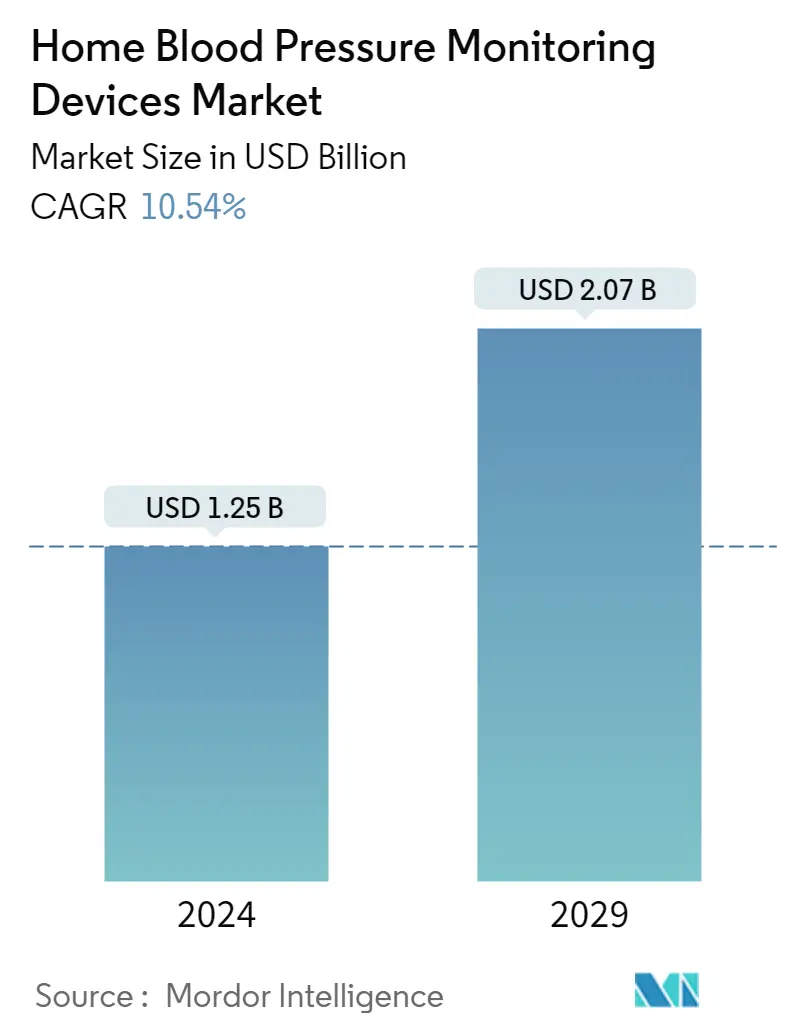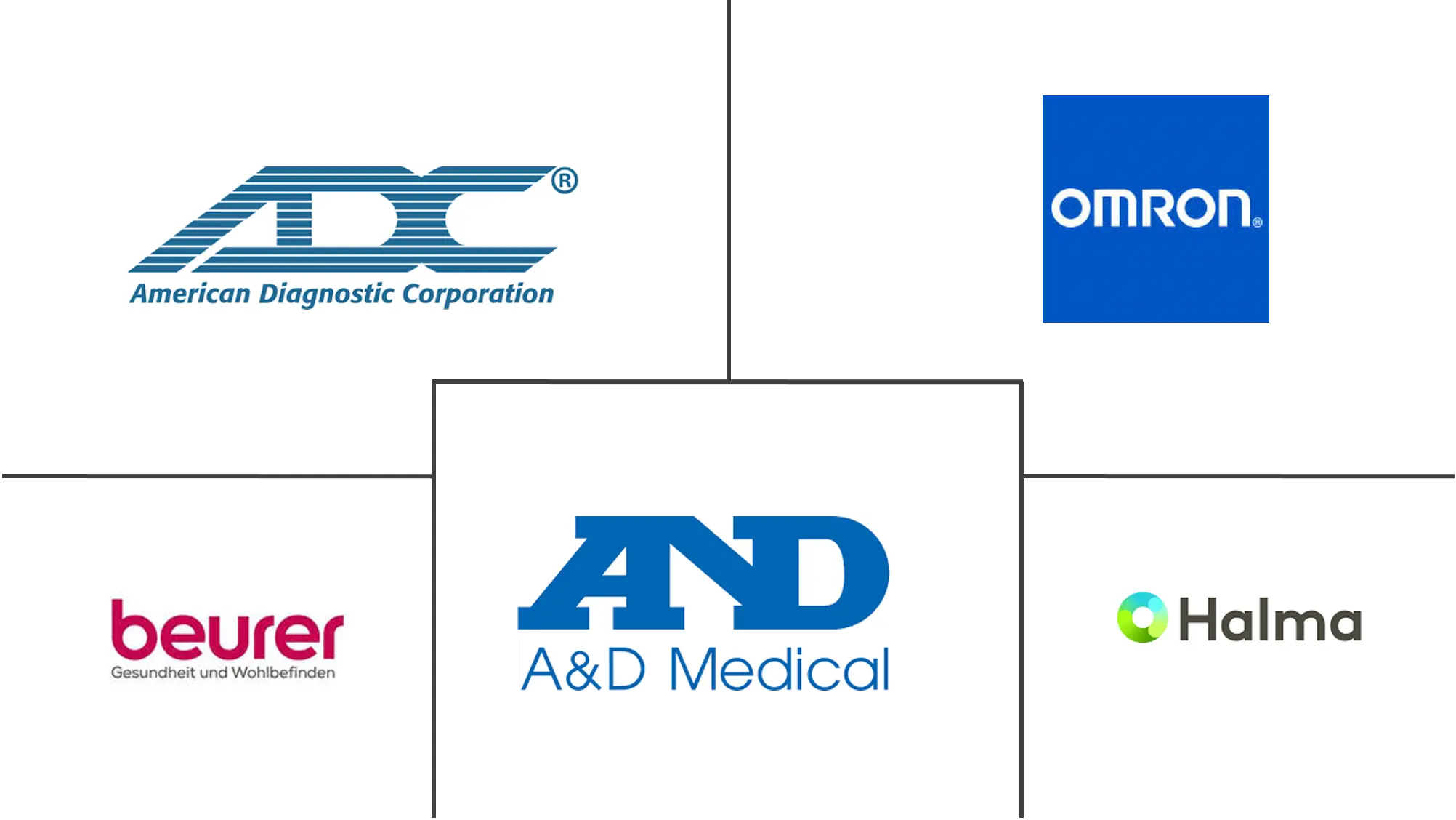
| Study Period | 2021 - 2029 |
| Base Year For Estimation | 2023 |
| Market Size (2024) | USD 1.25 Billion |
| Market Size (2029) | USD 2.07 Billion |
| CAGR (2024 - 2029) | 10.54 % |
| Fastest Growing Market | Asia-Pacific |
| Largest Market | North America |
Major Players
*Disclaimer: Major Players sorted in no particular order |
Home Blood Pressure Monitoring Devices Market Analysis
The Home Blood Pressure Monitoring Devices Market size is estimated at USD 1.25 billion in 2024, and is expected to reach USD 2.07 billion by 2029, growing at a CAGR of 10.54% during the forecast period (2024-2029).
The COVID-19 pandemic had a notable impact on the growth of the market due to the imposition of strict lockdown regulations in the initial stages of the pandemic. This resulted in the rising adoption of home blood pressure monitoring due to the increasing usage of telehealth services during the pandemic. For instance, an article published in the Journal of Comprehensive Clinical Medicine in March 2021 indicated that the use of home blood pressure tracking when paired with digital health technology facilitated remote telemonitoring of self-measured blood pressure values. The utilization of home blood pressure monitoring devices increased significantly during the COVID-19 pandemic. These factors had a significant impact on the growth of the market during the pandemic period. Also, the demand for home blood pressure monitoring devices is expected to remain intact during the post-pandemic period, thereby contributing to the growth of the market over the forecast period.
The major factor attributing to the growth of the market is the increase in the incidence of blood pressure-related diseases like heart attacks, cardiovascular diseases, aneurysms, and metabolic syndrome. According to the World Health Organization's key facts on hypertension published in August 2021, around 1.28 million people around the world in the age group of 30-79 years are affected by hypertension, with over two-thirds of them living in low- and middle-income countries. Such a high prevalence of hypertension among the global population is expected to drive the demand for home blood pressure monitoring devices. Also, the rise in cardiovascular diseases is expected to increase the demand for home blood pressure monitoring devices. For instance, the British Heart Foundation (BHF) data published in January 2022 reported that the most common heart conditions affected globally were coronary (ischemic) heart disease (global prevalence estimated at 200 million), peripheral arterial (vascular) disease (110 million), stroke (100 million), and atrial fibrillation (60 million). The report also mentioned that the prevalence of heart and circulatory diseases in North America was 46 million, in Europe it was 99 million, in Africa it was 58 million, in South America it was 32 million, and in Asia and Australia it was 310 million. Thus, the high incidence of various cardiovascular diseases among the global population is expected to contribute to the growth of the market.
Additionally, the increasing product developments by various key market players are expected to contribute to the growth of the market. For instance, in October 2022, Omron Healthcare developed a portfolio of blood pressure monitors by converting them into connected devices for ease of usage at home. This major update to the portfolio will help users and medical professionals manage hypertension in a way that is smooth, easy, and accurate.
However, the cost of the devices and their accuracy are expected to restrain the growth of the market over the forecast period.
Home Blood Pressure Monitoring Devices Industry Segmentation
As per the scope of the report, home blood pressure monitoring devices are used to monitor blood pressure at home regularly. Home monitoring is not a substitute for regular visits to the physician. The Home Blood Pressure Monitoring Devices market is segmented by product (upper arm monitors, wrist monitors, and accessories), distribution channel (hospital pharmacies, online pharmacies, and others), and geography (North America, Europe, Asia-Pacific, the Middle East and Africa, and South America). The market report also covers the estimated market sizes and trends of 17 countries across major regions globally. The report provides the above segments' values in USD (US Dollar) million.
| Upper Arm Monitors |
| Wrist Monitors |
| Accessories |
| Hospital Pharmacies |
| Online Pharmacies |
| Other Distribution Channels |
| North America | United States |
| Canada | |
| Mexico | |
| Europe | Germany |
| United Kingdom | |
| France | |
| Italy | |
| Spain | |
| Rest of Europe | |
| Asia-Pacific | China |
| Japan | |
| India | |
| Australia | |
| South Korea | |
| Rest of Asia-Pacific | |
| Middle East and Africa | GCC |
| South Africa | |
| Rest of Middle East and Africa | |
| South America | Brazil |
| Argentina | |
| Rest of South America |
Home Blood Pressure Monitoring Devices Market Size Summary
The home blood pressure monitoring devices market is poised for significant growth, driven by the increasing prevalence of hypertension and cardiovascular diseases globally. The COVID-19 pandemic accelerated the adoption of these devices as telehealth services became more prevalent, highlighting the importance of remote health monitoring. This trend is expected to continue, supported by the rising incidence of blood pressure-related conditions such as heart attacks and metabolic syndrome. The demand for home monitoring devices is further bolstered by advancements in digital health technology, which facilitate accurate and convenient tracking of blood pressure levels. Key market players are actively developing innovative products, such as connected devices, to enhance user experience and improve health outcomes.
The market is characterized by a competitive landscape with several major players, including Omron Healthcare, A&D Medical, and Philips, leading the charge in product development and innovation. The wrist monitor segment is gaining traction due to its portability and ease of use, particularly for individuals with mobility limitations. North America is expected to maintain a significant market share, supported by a robust healthcare infrastructure and high prevalence of hypertension. Government initiatives and research partnerships in the region are anticipated to further drive market growth. Despite challenges such as device cost and accuracy, the market is set to expand, fueled by ongoing product launches and technological advancements.
Home Blood Pressure Monitoring Devices Market Size - Table of Contents
1. MARKET DYNAMICS
- 1.1 Market Overview
-
1.2 Market Drivers
- 1.2.1 Growing Burden of Blood Pressure-Related Diseases
- 1.2.2 Rise in the Use of Home Blood Pressure Monitors and Active Promotions
- 1.2.3 Advancements in the Devices
-
1.3 Market Restraints
- 1.3.1 High Cost and Accuracy of Devices
-
1.4 Porter's Five Forces Analysis
- 1.4.1 Threat of New Entrants
- 1.4.2 Bargaining Power of Buyers/Consumers
- 1.4.3 Bargaining Power of Suppliers
- 1.4.4 Threat of Substitute Products
- 1.4.5 Intensity of Competitive Rivalry
2. MARKET SEGMENTATION (Market Size by Value - in USD Millions)
-
2.1 By Product
- 2.1.1 Upper Arm Monitors
- 2.1.2 Wrist Monitors
- 2.1.3 Accessories
-
2.2 By Distribution Channel
- 2.2.1 Hospital Pharmacies
- 2.2.2 Online Pharmacies
- 2.2.3 Other Distribution Channels
-
2.3 Geography
- 2.3.1 North America
- 2.3.1.1 United States
- 2.3.1.2 Canada
- 2.3.1.3 Mexico
- 2.3.2 Europe
- 2.3.2.1 Germany
- 2.3.2.2 United Kingdom
- 2.3.2.3 France
- 2.3.2.4 Italy
- 2.3.2.5 Spain
- 2.3.2.6 Rest of Europe
- 2.3.3 Asia-Pacific
- 2.3.3.1 China
- 2.3.3.2 Japan
- 2.3.3.3 India
- 2.3.3.4 Australia
- 2.3.3.5 South Korea
- 2.3.3.6 Rest of Asia-Pacific
- 2.3.4 Middle East and Africa
- 2.3.4.1 GCC
- 2.3.4.2 South Africa
- 2.3.4.3 Rest of Middle East and Africa
- 2.3.5 South America
- 2.3.5.1 Brazil
- 2.3.5.2 Argentina
- 2.3.5.3 Rest of South America
Home Blood Pressure Monitoring Devices Market Research FAQs
How big is the Home Blood Pressure Monitoring Devices Market?
The Home Blood Pressure Monitoring Devices Market size is expected to reach USD 1.38 billion in 2025 and grow at a CAGR of 10.54% to reach USD 2.28 billion by 2030.
What is the current Home Blood Pressure Monitoring Devices Market size?
In 2025, the Home Blood Pressure Monitoring Devices Market size is expected to reach USD 1.38 billion.


